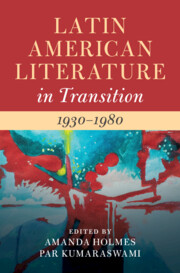Book contents
- Latin American Literature in Transition 1930–1980
- Latin American Literature in Transition
- Latin American Literature in Transition 1930–1980
- Copyright page
- Contents
- Contributors
- Introduction
- Part I War, Revolution, Dictatorship
- Part II Metropolis and Ruins
- Part III Solidarity
- Part IV Aesthetics and Innovation
- Chapter 14 Eros
- Chapter 15 The Return of the Galleons
- Chapter 16 “Un Híbrido de Halcón y Jicotea”
- Chapter 17 Literature and Revolution in Transition
- Chapter 18 Divergence and Convergence
- Chapter 19 Cortázar’s Transitional Poetics
- Index
- References
Chapter 16 - “Un Híbrido de Halcón y Jicotea”
Testimonio and Its Challenge to the Latin American Literary Canon
from Part IV - Aesthetics and Innovation
Published online by Cambridge University Press: 24 January 2023
- Latin American Literature in Transition 1930–1980
- Latin American Literature in Transition
- Latin American Literature in Transition 1930–1980
- Copyright page
- Contents
- Contributors
- Introduction
- Part I War, Revolution, Dictatorship
- Part II Metropolis and Ruins
- Part III Solidarity
- Part IV Aesthetics and Innovation
- Chapter 14 Eros
- Chapter 15 The Return of the Galleons
- Chapter 16 “Un Híbrido de Halcón y Jicotea”
- Chapter 17 Literature and Revolution in Transition
- Chapter 18 Divergence and Convergence
- Chapter 19 Cortázar’s Transitional Poetics
- Index
- References
Summary
This chapter examines the tensions between the supporters of two modes of writing Latin America – magical realism and testimonial writing – under the lens of the figures of the falcon and the tortoise, a simile employed by one of Cuba’s first and most prominent theorists of testimonio, Miguel Barnet. It explores how the hybrid mode of testimonio was conceptualized in the first two decades of the 1959 Cuban Revolution and, more generally, in Latin America, and how these concepts presented a challenge to the literary establishment in Latin America and beyond. Through examining the key positioning of Cuban testimonio in the first two decades of the Cuban Revolution, the chapter argues that the role assigned to testimonio in these early conceptual formulations shared many commonalities with the aims of magical realism, but also some important differences based on positionality and power. As such, the schism of 1971 represented not only a political fracture between Cuba and some Latin American nations but also a tipping point, or moment of transition, in terms of Latin American literatures’ potential in the world.
Keywords
- Type
- Chapter
- Information
- Latin American Literature in Transition 1930–1980 , pp. 260 - 274Publisher: Cambridge University PressPrint publication year: 2022

